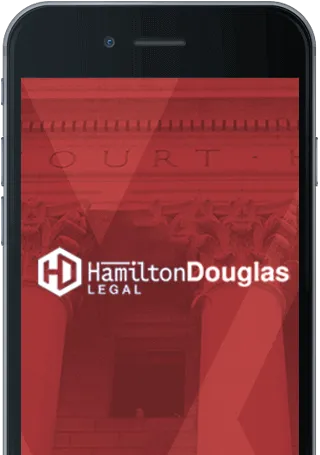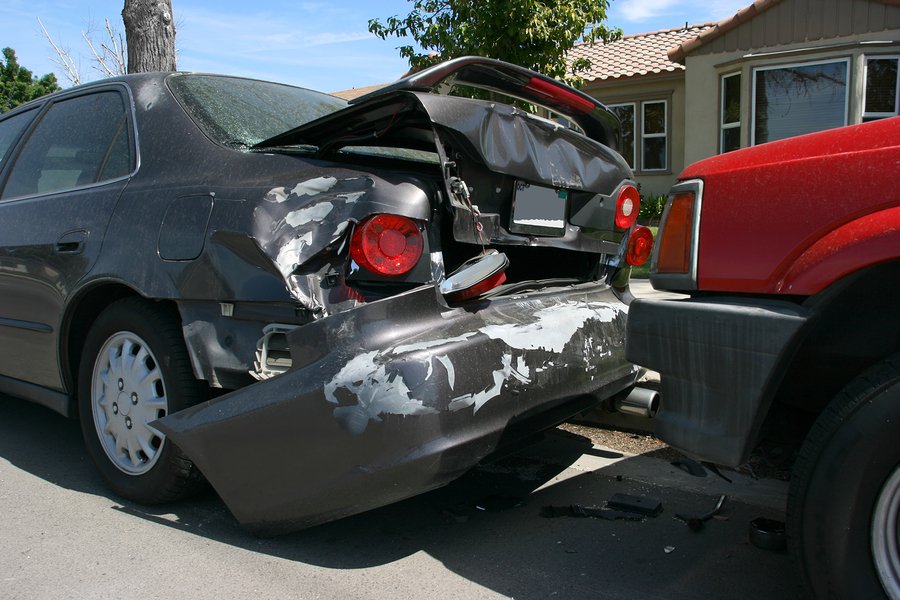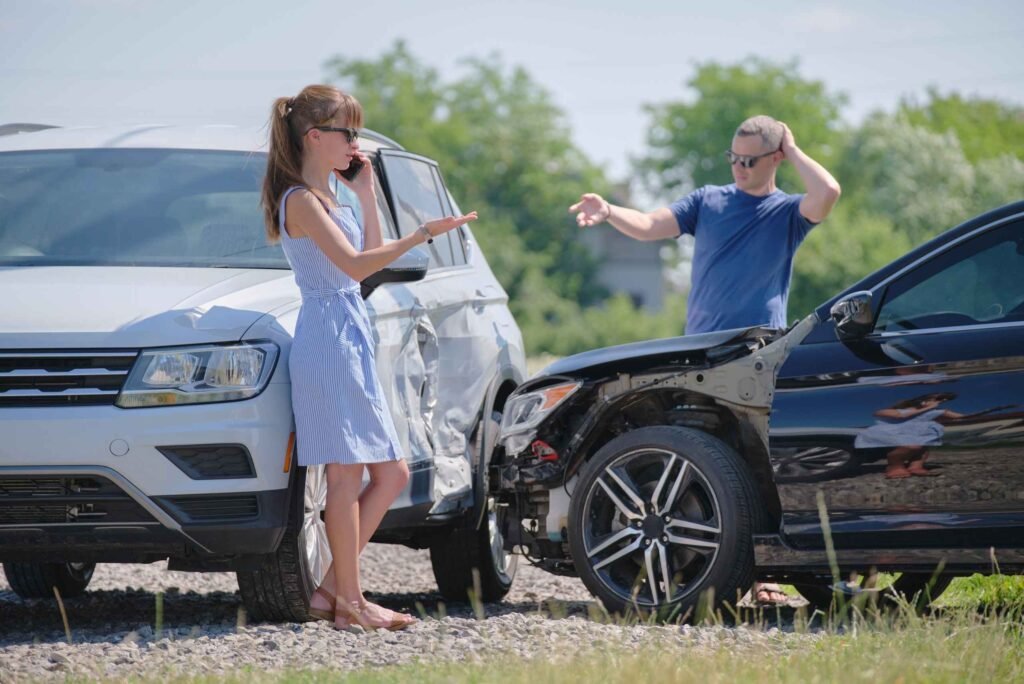When Is A Rear End Collision Not Your Fault?

Sarah John's
Legal Writer
Usually, the driver who hit the other car from behind is at fault. If the driver in front suddenly stops in the middle of the road without a valid reason, and your car hits them from behind, they could be held responsible for the accident.
Nevertheless, the car accident hit from behind settlement is impossible to predict beforehand. In case of an accident, Hamilton Douglas Legal panel of solicitors can help you make a claim.
Table of Contents

Get In Touch With Your Local Office:
With local knowledge and a national network of experts, we have the experience you can count on.
How Can I Prove That I Am Not At Fault In A Car Accident?
If you have been involved in a car crash rear end collision and you want to prove that you are not at fault, it is important to understand the process of determining liability. Generally speaking, the last driver to hit a vehicle is usually held liable for any damages or injuries caused by the collision. However, there are several other factors that may influence how fault is determined in a car accident.
The first step in proving that you are not at fault in a car accident is to gather evidence from the scene of the crash. This can include photos of the damage done to your vehicle and any debris from either party’s cars. Additionally, it may be possible to obtain eyewitness accounts from anyone who witnessed what happened leading up to and immediately after the crash.
Who Is The Fault In A Rear-End Collision?
When Is A Rear-end Collision Not Your Fault? When it comes to a car rear end crash, determining who is at fault can be complicated and confusing. Such accidents often occur in heavy traffic due to one driver not keeping a safe distance from the vehicle ahead. So who is liable when such an accident occurs?
In most cases, the car that hits you from behind is held responsible for any resulting damages or injuries. This is because drivers are expected to keep a safe distance from other vehicles on the road and anticipate sudden stops in traffic. The driver of the rear car must pay for any damage caused by their failure to maintain an appropriate following distance.
However, if both cars were travelling at excessive speeds or if either driver was distracted while operating their vehicles, liability may be shared between both parties.
What Is A Rear End Shunt Collision?
A car crash rear end collision is a common type of car accident that occurs when one vehicle strikes the back of another vehicle. This type of rear-ender can cause significant damage to both cars and can lead to serious injuries for those involved.
Rear end collisions are usually caused by an inattentive or distracted driver who isn’t paying attention to the road ahead or reacts too late when they see another car stopped in front of them.
Injuries sustained during a rear ended car collision can range from minor soft tissue damage, such as whiplash, to more severe lacerations and fractures resulting from impact with the windshield or dashboard.
Regardless of the severity of the crash, individuals should always seek medical attention immediately following any accidents – even if there are no visible signs of injury. A doctor will be able to assess any potential damage and provide appropriate treatments if necessary.
Common Factors: If You Are Rear Ended Who’s At Fault
If you’ve been involved in a rear ender in Scotland, you may be wondering who is at fault. This can be a difficult question to answer, but there are some common factors that will help determine the responsible party.
The first factor is whether or not the driver or the car behind was paying attention to the road and maintaining a safe distance between vehicles. If it has been determined that they weren’t paying attention or were too close, then they will likely be held responsible for any damage done to your vehicle as well as any injuries you may have suffered due to the accident.
Our panel of No win no fee solicitors in Scotland can help people who have been involved in rear-end collisions understand their rights and responsibilities for the damages caused by these accidents; they can also guide you if you want to cancel a claim.
Who Is Liable In A Rear-end Shunt Accident?
The unfortunate reality of road accidents is that they can befall anyone at any time. Rear-end shunts are a common form of car accident, and they can result in serious injury or even death. When this happens, it’s important to know who is liable for the resulting damages.
A rear-end shunt occurs when one car hits another car from behind while driving. The driver in the back usually assumes liability for the accident because it is their responsibility to maintain a safe distance between cars and avoid collisions.
However, there are certain circumstances that may shift blame away from them, such as if the leading vehicle suddenly brakes without warning or if a third party contributes to the collision due to negligence or recklessness. To get a free consultation from our panel of no win no fee solicitors Scotland, contact us today.
DEDICATED CLAIMS ADVISORS
Our dedicated claims advisors are always available to offer free legal advice.
100% NO WIN NO FEE CLAIMS
All our claims are processed on a No Win No Fee basis; you pay nothing if you lose.

MILLIONS SECURED IN DAMAGES
To date, we have secured millions in damages.
THOUSANDS OF SATISFIED CLIENTS
To date, we have helped thousands of clients recover compensation and continue to do so.
What Types Of Injuries Are Caused By Rear-end Shunts?
Rear-end shunts are one of the most common types of car accidents in Scotland. A rear-end shunt occurs when a car is hit from behind by another vehicle, and it can cause serious injuries to those involved in the accident. Our panel of personal injury solicitors Scotland can help victims recover damages after a rear-end shunt.
Most commonly, rear-end shunts cause whiplash or soft tissue injuries. Whiplash is caused by the sudden jerking motion of the head and neck that results from being hit from behind in a car accident.
Symptoms may include headaches, neck pain, dizziness, and stiffness. Soft tissue injuries refer to damage to muscles and ligaments, which can also be caused by rear-end shunt accidents.
What Is One Of The Main Causes Of Rear-end Collisions?
Rear-end collisions are one of the most common types of car accidents. They occur when a vehicle crashes into the back of another vehicle, often resulting in serious injury for those involved. Knowing what causes rear-end collisions can help drivers reduce their risk and better understand how to stay safe on the road.
One of the main causes of rear-end collisions is distracted driving. When a driver fails to pay attention to their surroundings, it becomes easier for them to miss important cues that would otherwise allow them to react in time and prevent an accident.
Distracted driving can come in many forms, such as texting while driving or talking on a cellphone, but any form of distraction takes away from a driver’s ability to be aware and focused on the road ahead. This puts other drivers at risk of being hit by someone who is not paying attention while behind the wheel.
What Is The Average Settlement For A Rear Shunt Accident?
Accidents resulting from a car rear ended by another vehicle are unfortunately common occurrences on our roads. The question of if a car hits you and you hit another car, who is at fault often arises in these situations. It is estimated that 40-50% of all crashes involve a rear-end collision.
A rear shunt accident, sometimes referred to as a rear ender or whiplash injury, can happen when one vehicle collides with the back of another. These types of accidents can cause serious and lasting injuries and may even result in fatalities. So what is the average settlement for a rear shunt accident?
The answer to this question depends on several factors, such as the severity of the injuries sustained in the crash, any available insurance coverage, and whether any fault was attributed to either driver involved in the accident.
In some cases, compensation for emotional distress may also be considered in addition to physical injuries, ranging from thousands to hundreds of thousands, depending on these variables.

Can’t Work Due To Illness Or Injury?
Use our free online claim check tool and find out in minutes if you have a claim.
Time Limits To Claim For Rear End Collisions
Accidents can be a major source of worry and stress for anyone involved, but there are certain types of car accidents that have specific guidelines regarding what to do afterwards. Rear-end collisions, in particular, require fast action and knowledge about the rights of both parties involved.
When it comes to rear end accidents, there are time limits in place for making a claim with your insurance company or taking legal action against the other driver. It is important to understand these time limits so that you can take the necessary steps to protect yourself and your interests after getting rear-ended while stopped or stopping.
The statute of limitations in Scotland is three years from the date of the accident. It is important to note that if you fail to make personal injury claims Scotland within this allotted time frame, then you may lose out on any potential compensation or damages associated with your case, such as the depreciation value of the vehicle.
What To Do If You Hit A Car From Behind When Someone Stops Suddenly In Scotland
It is a frightening feeling when you realise that you have rear-ended another vehicle. The experience of being involved in a car accident, even if it is minor, can be an incredibly stressful and overwhelming situation for everyone involved. If the other driver has stopped suddenly, it can be difficult to know what to do next.
In Scotland, anyone who is involved in a car accident must contact the police immediately and report the accident. This is especially important if there are any injuries or extensive damage to either vehicle.
After calling the police, exchange insurance information with the other driver as soon as possible; this will ensure that both parties are aware of coverage details and contact information for their respective insurers.
It is also advisable to take photographs of both vehicles so that all evidence is documented accurately for claiming insurance after an accident or taking legal action should it become necessary.
Am I At Fault If I Hit A Car In Front Of Me Because He Slammed On His Brakes Very Suddenly?
If you rear-ended another vehicle due to that car’s sudden braking, it can be difficult to determine which driver is at fault. In some cases, the car in front of you may be solely responsible for the accident. However, other factors such as speed and distance between cars can also play a role in determining fault.
When assessing who is at fault in an accident like this, it is important to consider the actions of both drivers leading up to the moment of impact. If the car ahead of you suddenly stopped without warning – making it impossible for you to stop safely – then it’s driver could be determined as being entirely at fault for your collision.
On the other hand, if there was ample warning given and sufficient time for you to brake safely, then your reaction time and speed may come into question when deciding who was negligent in causing the accident.
FAQs
If a car hits you and you hit another car who is at fault?
In most cases, the driver who caused the first impact is held responsible. If another car hits you from behind and pushes your vehicle into a third car, the driver at the back is usually at fault. Your insurer and the police will look at the full chain of events to confirm this.
Who is at fault if the driver in front of me stopped suddenly and I drove into the back of his car?
You are normally expected to keep enough distance to stop safely, even if the car ahead slows down quickly. If the driver in front brakes without a good reason or behaves unpredictably, they may bear some responsibility. The evidence at the scene contributes to the understanding of what occurred and who is responsible for the accident.
If I hit a car from behind is it my fault?
Rear-end collisions are usually blamed on the driver at the back because they should leave a safe gap. There may be exceptions if the front driver behaved in a dangerous or unusual manner. It is important to gather evidence so that the full situation is understood.
If you drive into the back of someone is it your fault?
You are usually held responsible if you hit the car in front, as drivers must leave enough space to stop safely. This rule applies to all Scottish roads, even in slow or busy traffic. Fault may change only if the front driver acted in a way that no one could reasonably expect.
Whose fault is it if someone crashes into the back of your car?
If another driver hits the back of your car, they are normally considered at fault. They should have kept a safe distance and paid attention to the road. You may still need to provide evidence to support your claim, such as photos or witness details.
Whose fault is it when hit from behind in car?
A driver who runs into the back of another vehicle is usually blamed for the crash. They are expected to judge speed and distance and keep enough space from the car in front so they can stop in time. Fault may be shared if the front driver behaved in a sudden or unsafe way, but this is less common.
If someone pulls out in front of you and you hit them is it your fault UK?
If a driver pulls out in front of you without enough space, they are often at fault because they did not give way safely. You still need to show that you were driving at a safe speed and paying attention to the road. In Scotland, both insurers will look at the evidence to see if the other driver created a situation you could not avoid.
If you go into the back of someone is it always your fault?
You are usually blamed if you run into the back of another car, as drivers must leave enough space to stop in time. There are some cases where fault may be shared, such as when the front driver acts suddenly or recklessly. Evidence from the scene helps show exactly what happened and who is responsible.
Easy Ways To Get In Touch
We are here to help. Give us a call, request a call back or use our free claim check tool to get in touch with our friendly legal team. With local knowledge and a national network of experts, we have the experience you can count on.





